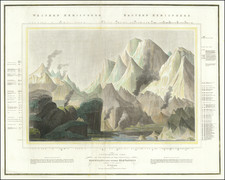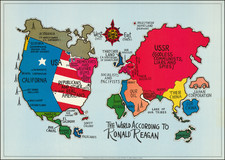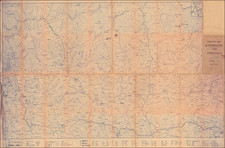Nice example of Bunting's map of Asia in the shape of the mythical winged horse Pegasus.
The horse is drawn fairly realistically, with a good deal of imagination required to view the map. The head represents Asia Minor, with the mouth at Istanbul. The wings portray Central Asia and Siberia. The Caspian Sea appears horizontally between the wings and the saddle. Persia is delineated on the horse's blanket, with the forelegs forming Arabia. The hind legs represent the Indian and Malay Peninsulas.
The map is among the earliest representations of a land mass in the form of an animal (or human).
Henrich Bunting was a Protestant theologian and teacher born in Hanover, in what is now Germany. He attended the University of Wittenberg and graduated in 1569. He then began work as a preacher but caused some controversy with his teachings; he was dismissed from appointments in both Lemgo and Goslar.
He is best known today for his book, Itinerarium Sacrae Scripturae (Travel book through Holy Scripture), a travel collection and commentary of the geography of the Bible. The book provided the most complete summary of biblical geography then available and described the Holy Land by following the travels of various notable people from the Old and New Testaments. First published in Madgeburg in 1581, Itinerarium Sacrae Scripturae was a very popular book for the time. Over 60 editions were published between 1581 and 1757.
A particularly notable feature of the book were its many woodcut maps, many of them showing unique depictions of geographic features and continents. In addition to the conventional maps, the book also contained three figurative maps; the world depicted using a cloverleaf design (thought to possibly represent the Trinity with Jerusalem in the center), Europe in the form of a crowned and robed woman, and Asia as the winged horse Pegasus.

![Asia Secunda Pars Terrae in Forma Pegasi [Asia in the Form of Pegasus] By Heinrich Bunting](https://storage.googleapis.com/raremaps/img/small/94173.jpg)











![New Plaine and Exact Map of Asia described by N I Visscher and rendered into English with the habits of the Countries and Manner of the Cheife Citties . . . [Carte-a-figures]](https://storage.googleapis.com/raremaps/img/small/93490.jpg)
![Vaisseau du Premier Rang avec ses Mats et Vergues, et quelques uns des principaux Cordages [Ship of the Line with her Masts and Yards, and Several Principal Riggins]](https://storage.googleapis.com/raremaps/img/small/88591.jpg)
